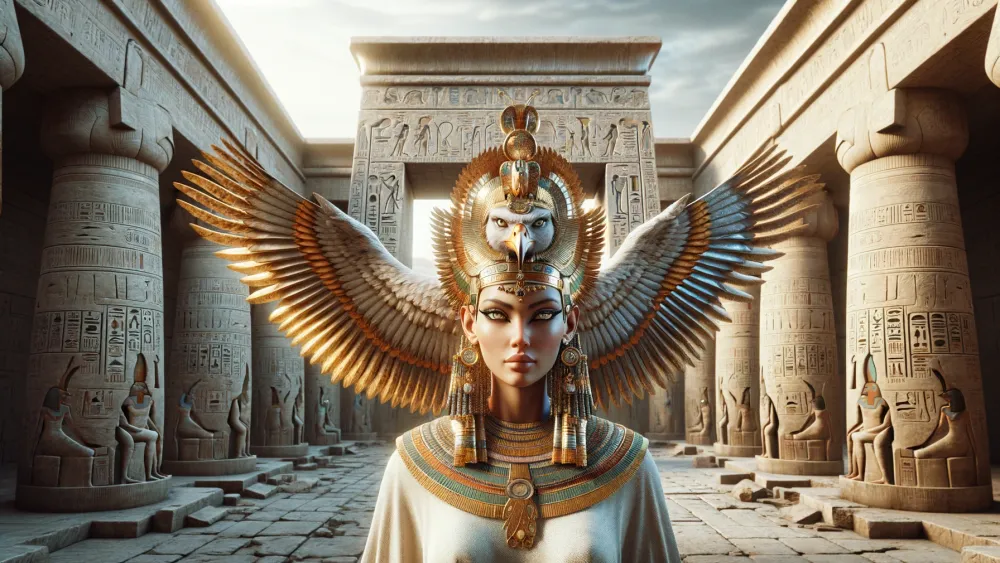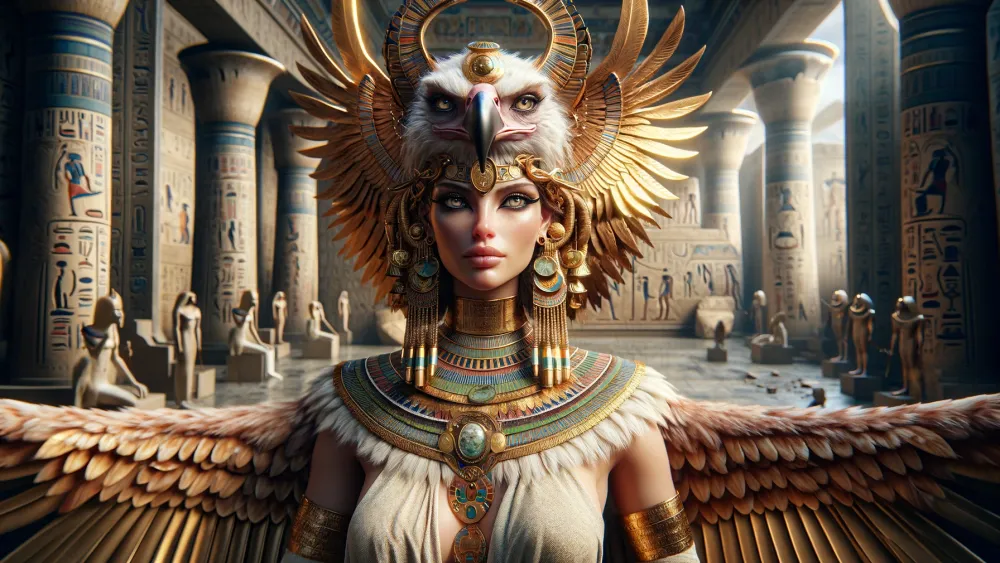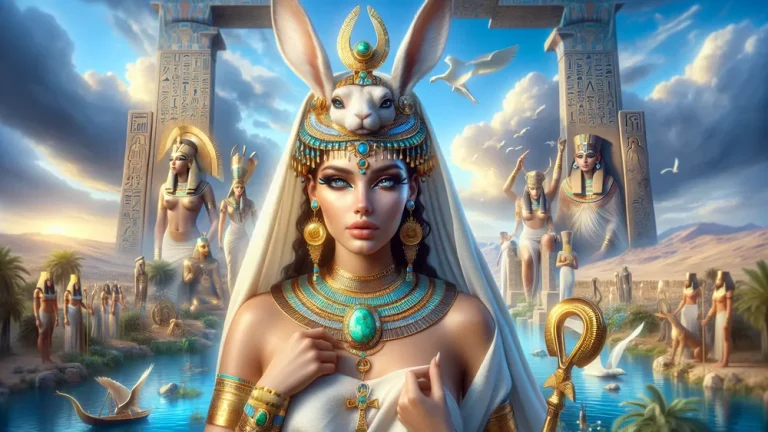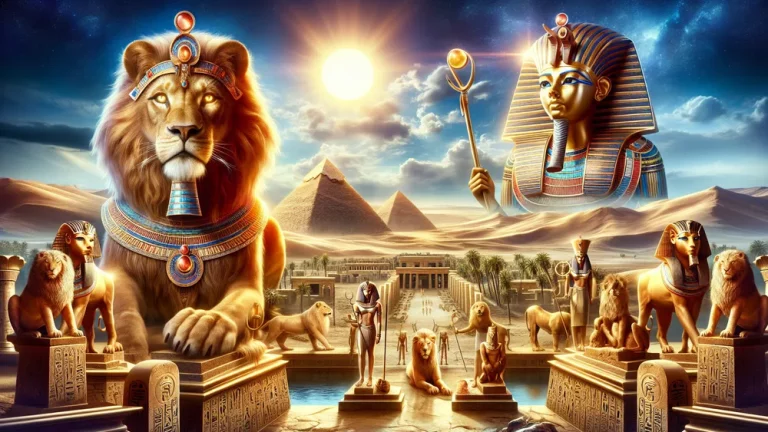Nekhbet: Vulture Goddess And Protector Of Upper Egypt
Nekhbet, the vulture goddess, plays a big role in ancient Egyptian stories as the protector of Upper Egypt. She was loved for looking after the pharaohs and being a symbol of motherly care. This blog post dives into where Nekhbet came from, how she was shown in art, and how people worshipped her.
Key Points:
- Nekhbet is the vulture goddess and protector of Upper Egypt.
- She symbolizes maternal care and protection for pharaohs.
- Nekhbet was worshipped mainly in Nekheb (El Kab).
- She is often shown as a vulture with outstretched wings.
- Nekhbet’s role includes protecting the pharaoh and children.
- Associated with the ‘Eye of Ra‘ for protection in battles.
- Nekhbet’s temple in Nekheb was a center for worship and offerings.
By looking at her importance in myths, her artistic images, and the temples built for her, we can better understand how this vulture goddess was both fierce and caring. Plus, we’ll see how she was part of everyday life and special ceremonies in ancient Egypt.
Origins and Mythological Significance of Nekhbet
Before we get into the details, let’s take a look at where Nekhbet came from and why she mattered so much to the ancient Egyptians. So, let’s jump into her story and see what made her special.
The Mythological Significance of Nekhbet in Ancient Egypt
Nekhbet’s story in Egyptian mythology goes way back to the early dynastic periods when she became a key deity. She was mainly worshipped in Nekheb (now El Kab), one of the oldest cities in Upper Egypt. As a vulture goddess, she was often shown as a vulture hovering protectively over the pharaoh or as a woman wearing a vulture headdress.
Given that vultures were seen as nurturing creatures, this attribute made Nekhbet a guardian figure. Her vulture form symbolized protection and maternal care, which were crucial for a deity linked to the nation’s and ruler’s well-being. Nekhbet’s role in ancient Egyptian religion was pretty diverse.
She was the protector of the pharaoh, ensuring his safety and success in both ruling and battles. Since she was tied to Upper Egypt, she represented the region’s divine power and authority. Pharaohs from Upper Egypt often called on her protection during coronations and military campaigns.
At the same time, Nekhbet was paired with Wadjet (the cobra goddess) who stood for Lower Egypt. Together, they symbolized the unity of Upper and Lower Egypt under the pharaoh’s rule. This pairing was often seen in royal symbols, where Nekhbet and Wadjet appeared together, showing their combined protective power over the whole nation.
Key Points:
- Worshipped in Nekheb (El Kab)
- Shown as a vulture or woman with vulture headdress
- Protector of the pharaoh
- Symbol of Upper Egypt
- Paired with Wadjet to show unified Egypt
Nekhbet, the vulture goddess, played a crucial role as the protector of the pharaoh and symbol of Upper Egypt, while her pairing with Wadjet represented the unity of Egypt.
Nekhbet’s Representation as a Vulture Goddess
In ancient Egypt, vultures were seen as symbols of protection and maternal care. This is because vultures were believed to be attentive mothers, always looking after their young ones. Consequently, the vulture became a powerful symbol for deities associated with nurturing and safeguarding. Nekhbet, as a vulture goddess, embodied these qualities. She was often depicted as a vulture with outstretched wings, hovering protectively over the pharaoh or important figures.

This imagery was meant to convey her role as a guardian and protector, ensuring the safety and prosperity of those under her watch. Nekhbet’s vulture form was not unique to her alone; other vulture deities existed in Egyptian mythology. For instance, Mut, another vulture goddess, was also associated with motherhood and protection.
However, while Mut was more connected to Thebes and the concept of divine motherhood, Nekhbet was specifically tied to Upper Egypt and the pharaohs. This regional association made Nekhbet’s vulture representation particularly significant in the context of royal power and authority. Unlike other vulture deities, Nekhbet’s imagery was often seen in royal regalia and artifacts, emphasizing her special role in protecting the pharaoh and the nation.
Key Points:
- Vultures symbolized protection and maternal care
- Nekhbet depicted as a vulture with outstretched wings
- Compared with other vulture deities like Mut
- Unique association with Upper Egypt and the pharaohs
Nekhbet’s Role and Symbolism
Given that we’ve looked at how Nekhbet is shown, let’s now dive into her different roles and what she symbolized in ancient Egyptian culture.
Nekhbet’s Patronage of the Pharaoh and Royalty
As for Nekhbet, she had a big role as the protector of the pharaoh in ancient Egyptian mythology. She was often shown hovering over the pharaoh with her wings spread out, which symbolized her protective nature. This wasn’t just for show; it had deep religious meaning. The pharaohs believed that Nekhbet’s presence kept them safe and successful, both in ruling and in battle.
Her vulture form, seen as caring and watchful, reinforced the idea that she was always looking out for the ruler, ready to offer protection and guidance. When it came to rituals and symbols tied to Nekhbet’s patronage, they were a big part of royal ceremonies.
For instance, during coronation rituals, the pharaoh would wear the White Crown of Upper Egypt, often decorated with vulture imagery to call on Nekhbet’s protection. Plus, amulets and artifacts featuring Nekhbet were commonly used to symbolize her guardianship. These items weren’t just for decoration; they were powerful talismans believed to provide divine protection.
In royal regalia, Nekhbet was frequently paired with Wadjet (the cobra goddess), representing the unity of Upper and Lower Egypt. This pairing was often seen in the form of Uraeus (rearing cobra) and vulture figures on the pharaoh’s crown, highlighting their combined protective power over the entire nation.
- Nekhbet as the protector of the pharaoh
- Vulture imagery during coronations
- Amulets and artifacts for divine protection
- Pairing with Wadjet to symbolize unity of Egypt
Nekhbet played a crucial role as the protector of the pharaoh in ancient Egyptian mythology, symbolized by her vulture form and represented through rituals and symbols in royal ceremonies.
Nekhbet’s Symbolism in the Protection of Children and Pregnant Women
Whenever it came to childbirth and protecting mothers, Nekhbet had a special place in ancient Egyptian mythology. She was often called upon to keep both the mother and the newborn safe during pregnancy and delivery. This protective side of Nekhbet was tied to her vulture symbolism, as vultures were seen as caring and attentive parents. So, many believed that calling on Nekhbet would ensure a safe childbirth and the well-being of both mom and baby.
To get Nekhbet’s protection, people used various symbols and amulets. For instance, vulture amulets were common, and mothers would wear them or keep them close during pregnancy and childbirth. These amulets were thought to carry Nekhbet’s protective powers, offering safety and comfort. Plus, images of Nekhbet with outstretched wings were often placed in nurseries or near cradles to watch over infants.
When you compare her role to other maternal deities in Egyptian mythology, Nekhbet had some things in common with goddesses like Taweret (the hippo goddess) and Isis (the goddess of motherhood). However, while Taweret focused more on fertility and Isis on magical protection, Nekhbet was mainly about vigilant guardianship during childbirth.
| Deity | Role in Childbirth and Protection |
|---|---|
| Nekhbet | Guardian during childbirth and protector of moms and babies |
| Taweret | Focused on fertility and protection during pregnancy |
| Isis | Provided magical protection and care for moms and kids |
Nekhbet’s Involvement in Battle and Role as the ‘Eye of Ra’
Whenever it came to battles and warfare, Nekhbet had a big role in ancient Egyptian mythology. She was often shown as a vulture flying over the battlefield, symbolizing her protective presence. Soldiers and generals would call on her for protection and victory, believing that her watchful eyes would guide them to success.
Her vulture form, known for keen vision and vigilance, made her an ideal guardian in the chaos of war. This belief was so strong that many military standards and banners featured her image, reinforcing her role as a divine protector in combat.
At the same time, Nekhbet was closely linked to the ‘Eye of Ra’, a powerful symbol in Egyptian mythology. The ‘Eye of Ra’ stood for the sun god’s wrath and protective power, and Nekhbet was one of the deities who could take on this role.
As the ‘Eye of Ra’, she was seen as a fierce protector who could unleash devastating power against enemies. This connection added another layer to her protective role, especially in military contexts. Soldiers believed that with Nekhbet as the ‘Eye of Ra’ watching over them, they had the divine force needed to overcome their foes.
- Nekhbet’s role in battles and warfare
- Vulture imagery on military standards
- Link with the ‘Eye of Ra’ for extra protection
Nekhbet played a crucial role in ancient Egyptian warfare as a protective vulture deity and as the powerful ‘Eye of Ra’.
Temples and Worship of Nekhbet
Since she played such a big role in protection and warfare, it’s no wonder Nekhbet was highly respected in ancient Egypt. Let’s dive into how people worshipped her, especially in her special temples.
Nekhbet’s Temple in Nekheb and its Significance
Nekhbet’s temple in Nekheb (modern-day El Kab) was a major spot for those who worshipped her. Located in Upper Egypt, this temple was a key place for people who saw Nekhbet as the protector of the pharaoh and the nation. The temple complex had several parts, like sanctuaries, courtyards, and possibly even living areas for priests. The main sanctuary held the statue of Nekhbet, where people made offerings and said prayers.

This temple wasn’t just a religious center but also a place where folks came to seek protection and blessings from the vulture goddess. As for the architectural features, they were pretty impressive. The temple was built with large stone blocks and decorated with detailed carvings and hieroglyphs showing scenes of worship and offerings to Nekhbet. The walls often showed the goddess with outstretched wings, symbolizing her protective nature.
Historically, the temple was important in the religious and political life of Upper Egypt. Various rituals and ceremonies took place here, including offerings of food, drink, and other valuable items to gain Nekhbet’s favor. Festivals were also held in her honor, where priests and worshippers would join in processions and other religious activities.
- Main sanctuary with Nekhbet’s statue
- Detailed carvings and hieroglyphs
- Rituals and ceremonies for protection and blessings
Rituals and Offerings Dedicated to Nekhbet
In ancient Egypt, people performed various rituals to honor Nekhbet. These rituals often took place in her temples, especially in Nekheb. One common ritual involved priests and worshippers bringing offerings to the altar of Nekhbet’s statue. These offerings came with prayers and hymns that praised her protective qualities.
Another important ritual was the “stretching of the cord” ceremony, which showed the goddess’s role in protecting the land’s boundaries. During festivals, processions would happen where statues of Nekhbet were carried through the streets, letting everyone join in the veneration. As for common offerings, they included food items like bread and beer, along with precious items such as jewelry and amulets. Each offering had its own special meaning.
For instance, bread and beer were everyday essentials and symbolized sustenance and life. Jewelry and amulets, often marked with protective symbols, were believed to call on Nekhbet’s protection. These offerings weren’t just acts of devotion but also a way for people to seek the goddess’s favor in their daily lives.
The significance of these rituals lay in their ability to bring communities together in shared acts of worship. Common Offerings:
- Bread and beer (symbolizing sustenance and life)
- Jewelry and amulets (calling on protection)
- Prayers and hymns (praising her protective qualities)
Nekhbet in Ancient Egyptian Art and Iconography
Since she was so important, Nekhbet often showed up in different forms of art and iconography. Let’s dive into how she was depicted and what these images meant.
Nekhbet’s Depiction with the White Crown and Wadjet
Whenever Nekhbet is shown, she often wears the White Crown of Upper Egypt. This crown, called the Hedjet, shows her role as the protector of Upper Egypt. In many artworks, she appears as a vulture with outstretched wings, sometimes perched on the pharaoh’s head, highlighting her protective nature.
The White Crown itself is a tall, conical headdress worn by the rulers of Upper Egypt, and its presence in depictions of Nekhbet underscores her close ties with the pharaoh and the region she guards. Meanwhile, her link with Wadjet, the cobra goddess representing Lower Egypt, is also crucial. Together, Nekhbet and Wadjet are known as the Two Ladies (or Nebty), symbolizing the unification of Upper and Lower Egypt.
This duality often appears in art, where both goddesses are shown side by side, each wearing their respective crowns (the White Crown for Nekhbet and the Red Crown for Wadjet). This imagery highlights the balance and harmony between the two regions. The symbolism behind these depictions emphasizes the unity and strength of Egypt, with Nekhbet and Wadjet serving as divine protectors of the land and its people.
Key Symbols:
- White Crown (Hedjet) of Upper Egypt
- Vulture with outstretched wings
- Link with Wadjet (cobra goddess)
Nekhbet, adorned with the White Crown and linked with Wadjet, symbolizes unity and protection in Egypt.
Nekhbet’s Representation as a Woman or Vulture with Outstretched Wings
Whenever Nekhbet is shown, she often appears in two main forms: as a vulture and as a woman. When she’s depicted as a vulture, her wings are usually spread out, symbolizing protection and guardianship. This vulture form often hovers over the pharaoh, showing her role as a divine protector. Sometimes, she even wears the White Crown of Upper Egypt on her vulture head, highlighting her connection to the region.
As a woman, Nekhbet is usually seen with a vulture headdress, sometimes combined with the White Crown. These two forms emphasize her protective nature and divine authority. As for her outstretched wings, they carry a lot of meaning. They symbolize shelter and protection, much like how a vulture shields its young. This imagery isn’t unique to Nekhbet; other protective deities in Egyptian mythology also have outstretched wings.
For instance, the goddess Isis is often shown with wide-spread wings, offering protection to the deceased in the afterlife. Similarly, the goddess Mut is depicted with wings in her role as a mother and protector. These visual elements highlight the shared attribute of guardianship among these deities, but Nekhbet’s specific link to the vulture sets her apart in her special role as the protector of Upper Egypt.
Key Depictions:

- Vulture with outstretched wings
- Woman with vulture headdress
- White Crown of Upper Egypt
Pantheon of All the Egyptian Mythology Gods
Whenever you’re curious about the many gods and goddesses in Egyptian mythology, check out this list of all the Egyptian gods. It covers the major deities and their roles in ancient Egyptian religion.
FAQs
1. Who is Nekhbet in Egyptian mythology?
Nekhbet in Egyptian mythology is the vulture goddess who serves as the protector of Upper Egypt and the pharaohs.
2. What symbols are associated with Nekhbet?
Symbols associated with Nekhbet include the vulture, the White Crown of Upper Egypt, and the shen ring.
3. How was Nekhbet worshipped in ancient Egypt?
How Nekhbet was worshipped in ancient Egypt involved rituals, offerings, and ceremonies dedicated to her at temples, particularly in Nekheb.
4. What is the significance of Nekhbet’s vulture form?
The significance of Nekhbet’s vulture form lies in its representation of protection, maternal care, and guardianship over Upper Egypt and the pharaohs.







